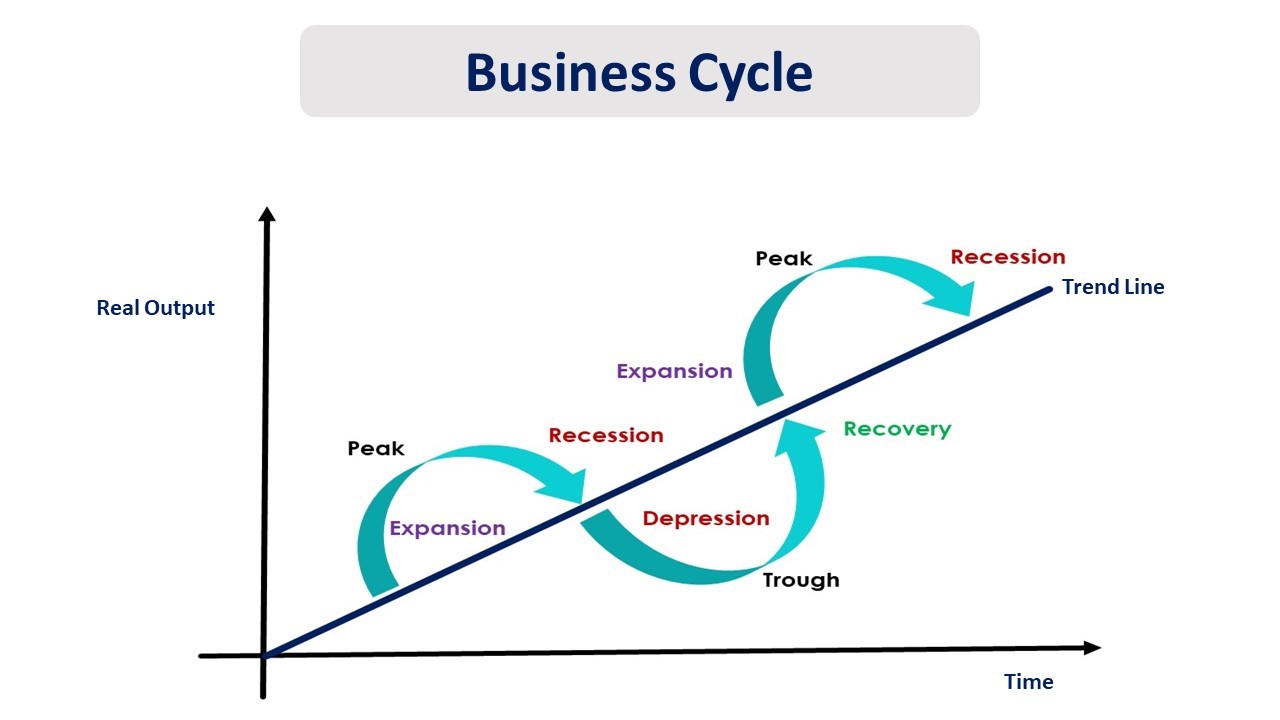What is Business Cycle?
Business cycle can be understood as the cycle of fluctuations in Gross Domestic Product (GDP) around its long-term natural growth rate. It is also known as trade cycle or economic cycle, it describes expansion and contraction within economy activities, which an economy or country experiences over a time interval.
Business cycle is considered as a completed cycle when it passes through a boom and a fall in a pattern or a sequence. The time-interval in which a business cycle completes itself refers to length of the business cycle. A boom or expansion shows a period of rapid economic growth. While, the period in which the economic growth decreases after the expansion period is a recession. These all-various phases of the business cycle are measured in terms of the growth of the real GDP, which assumes inflation-adjusted.
Phases in a Business Cycle

- Expansion: When we look at any business cycle, at the initial stage of a business cycle, an expansion appears which shows an increase within real output or other positive economic indicators such as employment, profits, wages, demand and supply of goods & services. But within this article, we are only assuming Real-GDP as the default real-output. This phase tells that the investment level of economy is high due to optimism of investors towards economy, people are running their businesses with profits or earning income. Consumers are consuming the goods and services at a higher level. Debtors are paying-back their debts on time due to profitability within their business or a good job. And this process continues itself until the economic-indicators do not go against these positive indicators or this expansionary phase.
- Peak: But till which moment an economy will do expansion, as we-all know that everything has its own limited potential or efficiency. The same applies within the business cycle, later on, expansion phase comes to a point at which it reaches to the peak of the real-output or we can also say that it reaches at a saturation point. Which shows that after this maximum-attained limit, the economic indicator or the real-output cannot grow further, and the prices are at their peaks. This point tells us that, the economic-growth is going to be in a reversal trend to restructure its budget.
- Recession: The recession phase follows the peak phase, consumers decrease their demands. While on the extra hand producers produce finished goods within the markets without knowing the level of consumer’s demands, and this process continues itself until the producers do not realize that the consumers are not willing to buy more products. But due to less demand from consumers and excess supply from producers, the prices of goods get decrement. And eventually, we get losses within their businesses. If this process goes on till 6 months or two financial-quarters then it introduces recession.
- Depression: The economic growth decreases due to less tax-collection from businesses and people. Due to losses within the business entities, people become jobless and unemployment rate increases. Which result steady decline within the economic growth rate over a long-term interval. This phase is known as Depression.
- Trough: Within this depression phase, the economic growth rate becomes negative. This phase goes on until the prices of factors, as well as demand and supply of goods and services, do not contract to their lowest point. And while further declining, this real-output reaches to the lowest point or to the trough. It can also be understood as the negative saturation point and can be assumed as the just opposite of peak stage.
- Recovery/Revival: Later on, the stage of recovery introduces itself, and the magnitude of economy's negative growth rate get reduced. We get increments in consumers' demands due to lower price rates, and consequently increments in supply from producers 'side. Again, the people try to build-up an optimistic environment towards investment within business entities. And the whole process continues until the economic growth rate does not reach back to the steady growth levels. Employment increases due to more demand within the economy, and central monetary and fiscal regulation authorities launches policies to boost the economy.
Effects of Business Cycle
During Expansion: Expansion phase is treated as a developing phase within the whole business cycle, which supports higher magnitude within positive economic indicators and less magnitude in case of negative indicators.
High Growth: High growth refers to these following factors:
- Increment in large investments
- Increment in employment
- Increment in Income and Expenditures
Inflation: As the investment forces itself within this phase, money supply also increases in the economy, more demand for factor inputs increases the prices of goods. Which results an increment in inflation rate.
Severe Competition: Due to more production from various firms within the industries, market acquisition competition becomes a hype which results non-productive expenditure on marketing the products.
During Recession: Recession phase is treated as a negative phase within the whole business cycle but not more than depression, which stands against higher magnitude within positive economic indicators and stands for higher magnitude in case of negative indicators.
- Excess Inventory: Business entities, who made or bought excess products or inventories for production during expansion phase face the troubles to keep unsold items within the companies.
- Unemployment: Due to less demand, the supply reduces, and due to the losses within business entities or firms fire their employees or shows inability to keep employees. Which results higher unemployment rate within the economy.
Powered by Froala Editor



